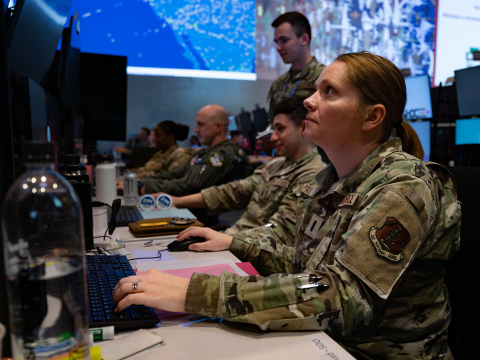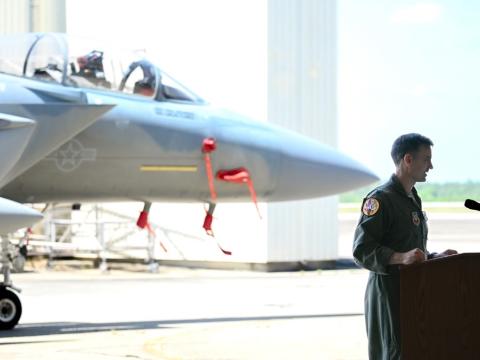Incoming: Air Superiority Is a National Defense Imperative
I suspect it is no surprise to the men and women who read SIGNAL Magazine that the U.S. Air Force is facing readiness and modernization challenges after 25 years of continuous combat.
I suspect it is no surprise to the men and women who read SIGNAL Magazine that the U.S. Air Force is facing readiness and modernization challenges after 25 years of continuous combat. What you readers might not realize, however, is that our Air Force is actually smaller today than it was when it became a service in 1947. And, according to recent congressional testimony, it sits at about 50 percent readiness. Across the board, our service members proudly carry out their missions as the world’s premier fighting forces. But if we are asking them to execute the published National Security Strategy, we owe it to these patriots to provide proper resources.
We need a national debate to address some crucial questions and make sure our elected leaders don’t kick this can down the road, leaving the discussion and its potentially unacceptable answers for their successors to tackle.
How long can the U.S. Air Force remain the pre-eminent world air power, given the current defense budget, the forecasted budget and the investments of other world actors, particularly Russia and China?
Under President Vladimir Putin, Russia has demonstrated its intent to return to superpower status. Before the global drop in oil prices, Putin rolled out an ambitious plan to invest in force modernization. And even though their economy has suffered over the last few years, the Russians still want to achieve that objective. They also have shown a willingness to challenge NATO, ignore European objections and expand their influence again, as they did in Ukraine. I believe a stronger U.S. Air Force forward presence in the West would have deterred such maneuvers.
The end of the Cold War and the emergence of conflicts in the Middle East brought about a drawdown of forces in Europe. The U.S. pivot to Asia also lessened emphasis on Europe, and it represents an acknowledgement of Asia’s strategic importance. Certainly, China’s economic and military expansion has been a cause for concern throughout the region. China’s buildup of the barrier reefs in the South Pacific is evidence of the nation’s disregard for the United States and its allies in the region. Despite protests, the Asian power openly has built a 10,000-foot runway with supporting infrastructure; Chinese leaders have claimed that it would be used for tourism purposes. The U.S. Pacific Command (PACOM) commander’s objections and his desire to more overtly express U.S. opposition to the action were overruled.
Both Russia and China also have felt confident enough with their air power to execute a series of dangerously close flybys of U.S. warplanes and warships. These seem to highlight a level of confidence and calculation that the United States has not seen for many years.
If more funding is not added to the Air Force’s budget soon, what future risks can we expect, and will the nation be prepared to accept them?
In addition to global power struggles, the service is confronting a labor shortfall of up to 60,000 airmen, estimates the Air Force chief of staff, and an aging fleet. The average age of a U.S. fighter aircraft is nearly 27 years. The bomber force is even older, averaging almost four decades. As these planes age, they need significantly more maintenance to ensure force readiness.
Our inventory is not as robust as it once was, and it is reasonable to assume there will be unintentional losses—such as the recent crash of a B-52H in Guam—before replacements are secured. Unfortunately, the pace of current operations, coupled with smaller budgets and higher acquisition costs than in the past, have moved Air Force modernization plans to the right and reduced the number of new aircraft to be purchased.
Despite these challenges, the Air Force has been able to maintain its air superiority and preserve freedom of maneuver for our land and sea forces in the Middle East. Fortunately, the air threat there has not been unmanageable, but this has not always been the case. During the Vietnam War, the United States took significant fighter, bomber and helicopter losses. We should not take our success in the Middle East for granted.
With the Air Force and all our services focused on the fight against terrorism and combat operations in developing nations, other countries are taking advantage of this preoccupation to modernize their forces, improve tactics and gain strategic footholds around the globe. This challenges our supremacy and concerns our allies.
U.S. air superiority is essential for preserving world peace and ensuring that our ground forces have the freedom to maneuver whenever peace is interrupted. The Air Force has responded to every challenge it has been issued, despite significant force pressures and reductions. Events around the world suggest that other nations sense that our Air Force is stretched thin and obviously cannot be everywhere at once. Congress must appropriate additional modernization dollars now, before we reach a point where we are no longer the pre-eminent air power of the world.
Lt. Gen. Mike Basla, USAF (Ret.), the former chief of information dominance and chief information officer of the U.S. Air Force, is the senior vice president of Healthcare, Litigation and Enterprise IT for CACI.




Comments